Just got back from my annual trip to Mississippi. I actually usually make more than one trip to Mississippi, but for the past eight years or so I’ve been back each summer to work at the Summer Scholars Onstage camp. It’s a theatre camp for junior high and high school students who write and produce a three act musical comedy in the space of three weeks. Of course, they have lots of guidance and direction at this, and I get to help with that.
Lo, back in the day, in the years of our Lord 1989 and 1990, I was a camper there myself. And for six years afterward, I stayed on as staff for writers camp, moving from writing assistant to act leader and eventually working my way up to boys counselor. After college, though, I got wrapped up in actual employment and a relationship with the lady who would become my wife that took up all of my vacation time. Ten years went by during which I did not have any relationship to the camp except as an alumnus. Each summer in July, though, I knew it continued and would feel the pain and longing of not being there. In 2006, I was asked if I would like to come back and give it a whirl on the writing staff again. I was an act leader, meaning I was in charge of helping guide the campers assigned to write one of the acts in the show. I had a blast doing it and made lots of new friends. I was unable to return in 2007, but came back in 2008 where I was given the new responsibility of Script Coordinator, who is the guy charged with guiding the whole show, giving notes to the acts on improvements to make, and, ultimately, editing the whole thing together. For all but one year since then I’ve continued in this role, helping to channel all of the amazing creative talent the students bring into a three act play, or three one act plays.
Now, many volumes could be written when it come to this camp, its history, the folks who’ve gone through it as campers, many of whom have gone on to work in professional theatre, media, acting, etc., and what the camp has meant in the lives of those who’ve attended it, not the least of which, from my perspective, is my own. But that’s not what I set out to write about today. Instead, I want to write about a cat.
Summer Scholars takes place at Mississippi State University, where the camp has been based from a variety of dorms. (The university prefers us to refer to them as “residence halls,” but we care not for such niceties. They’re dorms, dammit.) For the past several years, though, we’ve maintained a home in proximity to the theatre in which our show is performed. And it was outside of this dorm, early in the Writers Camp week, that I spotted a tiny orange kitten. I first saw the kitten on the way back from dinner, early during Writers Camp. It was lurking in a long row of bushes directly beside the busy campus road that runs in front of the dorm, moving from bush to bush, watching us as we walked back. The kitten looked like it was in rough shape. It had what looked like a puncture wound on its neck, surrounded by a patch of bare skin, almost as if it had been shaved; it also had blinky eyes, as though something was wrong with at least one of them. One of our party theorized it might also have some hip displasia.
At first I was determined not to have any thoughts about this kitten. It was one of hundreds of stray cats that live on MSU’s campus and I can’t save them all so there was no point in getting attached to this particular one. Never mind the fact that it looked remarkably similar to Winston, my cat from college through marriage, who died back in 2008. This was a completely different creature. It would move along to another dorm or another dumpster and that would be that. But I caught another glimpse of it through the window of the camp’s office and found myself being concerned that it was still lurking so close to the road. Other people on the staff and a few of the campers noticed it too, but all reports were that it would not allow anyone to get close.
A day passed and I didn’t see the kitten, though I still found myself looking for it. It was gone, though, and that was for the best. Hey, maybe it even had a home somewhere? Right? Then, on the way to lunch, I saw it creeping along the sidewalk, near the road again. Someone made the comment that it should be captured and taken to the Humane Society, which reportedly was a no-kill shelter. I thought this was a good idea, but no one seemed to have any definite plans to do anything about it. When one of the staff asked me if I needed anything from Wal-Mart, I gave her some money and asked her to pick up a small bag of kitten food. I didn’t know at that point that I was going to try and catch the cat, but I thought I could at least do something to help keep it healthy by feeding it. That night, I took some kitty food out in a cup, prepared to pour it on the ground. However, I found two small clear plastic bowls in the bushes. Food in one, water in the other. I then sprinkled some food in a couple of other places along the bushes and called it a day.
The food was all gone the following day, so I replaced it and then again the following day. By Saturday, though, I still hadn’t seen the actual kitten for a while. Any number of animals could have eaten the food, including exotics such as skunks–which are known to inhabit campus.
Saturday night, around 9 o’clock, as we walked back from the theatre, a small group of us were just entering the area of large concrete planters and seating areas outside the dorm when an orange streak bolted from one of them and skittered past the door and into the bushes. It was the kitty. Only as we approached the door, it popped back out and came creeping toward us, mewing pitifully. I went right in the dorm, right to my room and brought it out some cat food and water. I didn’t see it any more, though, no matter how much I called for it.
The following day was to be a big one. The second Sunday of camp is traditionally the day when I lock myself in a room for 15 plus hours and do a final pass edit of the script. It doesn’t matter how well-written the script is (and this one was pretty good going into editing) it’s going to take at least 15 hours to go over every single word of a 60 page document. I left my room early to catch breakfast so I could get started. And there at the front door was the little orange kitten, lapping milk out of a bowl one of the campers had placed outside. For some reason, the sight of this made me tear up, both at the pitiful appearance of the cat, with its puncture wound and blinky eyes, but also for the compassion shown by the kids toward it. The chief compassionate camper was a girl named Olivia, who lives on a farm and has a soft spot in her heart for animals of all kinds. I told her I’d been feeding the cat already, but that I was going to have to leave camp to head back home soon. That being the case, I would turn my bag of kitty food over to her. She instantly understood this meant she would be able to keep feeding it. Even as I said it, though, the idea of simply capturing the cat and taking it to the humane society came to mind again. It wouldn’t leave me, to the point that I finally looked up the hours for the humane society. They were not, naturally, open on Sunday, nor were they on Monday. They would not open until Tuesday at 11 a.m. I then texted my dad to ask if he happened to have a cat carrier. Their last cat, Thug, passed away a couple of years ago, but I figured they had kept his carrier since it would also fit their tiny dogs. They had. I also knew my dad had a small live trap, cause I’d seen it. Plans began to formulate.
On Monday, the script complete, I got it printed and delivered to the campers so they could begin deciding which characters they wanted to audition for Monday night. I then popped over to Dad’s to pick up the trap and the carrier. The trap itself was pretty small, probably ideally suited for a rat, but I thought it might just work for a kitten. It was a rectangular cage with a door at either end that could, ideally, be set to close as soon as a creature touched the triggering platform at the center of the cage’s interior floor. Unfortunately, its operation was not completely obvious and it had been long enough since Dad had used it that he was not entirely sure how to set it. I took it back to the dorm and got my buddy Joe to have a look, since he’s good at solving puzzles. He figured it out and showed me how to set it. Now for bait.
I was afraid it might be a chore to find Olivia, but she was standing in the camp office as I came out of the staff hallway and was the first person I saw. She saw the trap and immediately knew what my plan was. She ran up to her room with a cup to fetch some kitty food. I took it and a bottle of water with me and went outside, retrieving the plastic bowls from their place in the bushes. I placed food and water into the cage, set the mechanism and gingerly lowered the whole thing behind a semi-circular concrete bench, located midway between the front door and the northernmost edge of the dorm. It was not a high traffic area and I figured the trap would be out of sight of passers by, but still likely in the kitty’s range. I saw no sign of the kitty while doing this, so I walked back along the entire length of the dorm searching for it. When I reached the southern end and turned to come back, who should I see on the sidewalk just beside the area I’d left the trap, but the little orange kitty. It mewed at me as I approached, but skittered away when I came closer than 10 feet.
I sat down on the concrete wall across from the semi-circle bench and stared into the decorative bushes and trees beyond it. Eventually I saw a kitty face peeking among the leaves. I called to it softly.
My friend and fellow staffer Leah Rabbideau came walking up shortly after this. She had heard about the kitty and was happy to hear that I was trying to capture it. As we talked, the kitty jumped up on the semi-circular bench and mewed at us.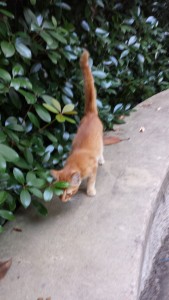 I quickly took its picture with my phone, as I didn’t know if I would have another chance, but it didn’t like the movement very much. I gave Leah my keys and asked if she would go to my car and get the cat carrier, because I might just need it. Capturing the cat by hand was not part of my original plan—especially with less than half an hour left before I had to be at auditions and supper still uneaten. But you know what they say about a kitten in hand being worth more than two in a live trap in the bush.
I quickly took its picture with my phone, as I didn’t know if I would have another chance, but it didn’t like the movement very much. I gave Leah my keys and asked if she would go to my car and get the cat carrier, because I might just need it. Capturing the cat by hand was not part of my original plan—especially with less than half an hour left before I had to be at auditions and supper still uneaten. But you know what they say about a kitten in hand being worth more than two in a live trap in the bush.
I cautiously moved over to the semi-circular wall and sat on the edge of it. I poured some dry foot out on it, a couple of feet away from me, and the kitty came over to have a bite. Any time I moved my hand to reach for it, though, it would skitter away a few feet. I continued to try, hoping it would let me pet it and pick it up, hoping it wouldn’t then bite me and force me to take rabies shots, but it wouldn’t let me even move. We kept up the routine even after Leah returned with the carrier.
I then tried to stand and move into a position where I could better block the kitty’s escape. It decided to show me that this was foolhardy of me by disappearing off the back side of the bench and into the shrubbery. At least the trap was back there with it, I thought, but heard no SNAP of it closing shut. I retreated back to my original seat, across the sidewalk, where I kept a view of the brush. Eventually the kitty reappeared within it, laying prone on the ground within it, tucked in a sunbeam, where it washed and stretched and flexed its claws in the air. I stood up to get a better view and the cat didn’t seem at all bothered. It was like it was saying: “Yeah, I know you want to get me, but you caaaaaan’t.” I tried coaxing it with soft words and by scratching a brown magnolia leaf along the concrete, but it was having none of it.
I was getting hungry. By my phone, it was 5:50, which meant I only had ten minutes until auditions and I still had not eaten. There was a very real danger that the campers had devoured all of whatever food we were having that night, too. I might be staring at jelly beans for dinner if I wasn’t careful. I silently prayed that if I was meant to capture this cat, God might intervene on my behalf.
After a bit the cat gave up with luxuriating and got up to go explore. It moved out-of-sight, but toward the 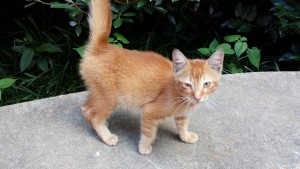 trap. I braced, waiting for the metallic clank, but heard nothing. I didn’t dare risk peeking over the lip of the concrete seat, though, for fear of scaring it away from the trap, assuming it was already there. Then I again spotted the kitty moving in the brush. I called to it, telling it how sweet it was, how I just wanted to help it, and how it would have a safe new home if only it would come out and let me catch it. I guess I was far enough away from the bench that I was not seen as a danger, for the kitty hopped back up on the curved bench and mewed.
trap. I braced, waiting for the metallic clank, but heard nothing. I didn’t dare risk peeking over the lip of the concrete seat, though, for fear of scaring it away from the trap, assuming it was already there. Then I again spotted the kitty moving in the brush. I called to it, telling it how sweet it was, how I just wanted to help it, and how it would have a safe new home if only it would come out and let me catch it. I guess I was far enough away from the bench that I was not seen as a danger, for the kitty hopped back up on the curved bench and mewed.
I remained still and just continued to talk to it. It wanted to move back down to where I had food sprinkled, so I tried to gently ease my way in that direction, but every step made it scurry away along the bench. I soon found myself between it and the food, so I went and sat on the bench and held out my hand to the cat. It mewed, but wouldn’t move closer until I lowered my hand. Every time it would approach, though, I would slowly raise my hand, palm down, fingers loose, hoping it would see this move as friendly. It took a couple of minutes, but the kitty finally came close enough that it could sniff my hand, but then it darted away again. So we went through the process again, with the kitty lingering with its sniff before darting away. Then it lingered and let me touch its nose. Then the top of its head. I prayed and prayed that I wouldn’t do something to scare it away for good and that no cars would backfire and startle it. It was nearly time for auditions to begin, but I couldn’t give up and trust the trap to work if I was this close to befriending it.
At last, the kitty got close enough for me to not only touch the top of its head but to scratch it behind the ears. And that was all it took. It was like the kitty had never been petted, but had always wanted to be, and now that it was getting its ears scratched it was fully locked in place with no fear. I did not immediately try to pick it up, but continued just petting it and scratching it. The kitty purred loudly and rubbed its head on my hand. Then, I calmly curled my fingers around its underside and lifted it to my chest. It didn’t make a peep, didn’t claw me, or give me any trouble at all. I stood up, walked over to the cat carrier, pulled open the door and placed the kitten inside before locking it shut. Then I took a breath, because evidently I had not been breathing for some time.
I gathered trap and carrier and headed back inside. A number of kids saw what I was carrying and came running up to ask about it.
“You caught the kitty!” more than one said.
“Shhhhhhh!” I said in return.
Members of the dormitory in-house staff were hanging out at the central desk in the lobby and I had not wanted to draw their attention. There are strict rules against animals in the dorm and the last thing I would want to happen is to cause any trouble for camp. One of the dorm staffers did seem to give me a glance, but didn’t seem to register what I was carrying. Just in case, though, I headed past the desk and toward the back door, as if leaving with my prize. I turned back at the door to see if I was being watched, but I did not appear to be, so I booked it for the camp office.
On the way, I spotted Olivia waiting for the elevator and held up the carrier proudly to let her know I had been successful. We set the carrier down in the office so people could look in and see the kitten. It didn’t seem too put out by the attention. While I was standing there, though, I decided to go ahead and hit the trip switch in the trap to close up it’s doors, rather than risk it tripping on its own and startling me or the cat. I reached in and hit the switch. Nothing happened. I hit it again, this time with more force. The doors remained up. I had managed to set the trap in such a way that it would not have worked at all. If I had not caught the cat by hand, I would not have caught the cat.
I left the carrier in my room, then dashed back to where dinner had been laid out, grabbed a heaping spoonful of spaghetti and then headed for the auditions room. On the way, I asked another staffer if she would mind making sure the kitty had food and water in the carrier. Before auditions began, I wrote to my wife to let her know of my success. “Will we have a new cat?” she texted back. “Not if I can help it,” I replied. Shortly after this, my dad texted me to find out if I was going to join them for breakfast.
“Complicated. I caught the cat,” I texted.
“Cool! How about bring it by and show us?” he replied.
Gears in my head began to mesh, but it was too soon to call it a thought machine.
During breaks in auditions, I went back to my room to check on the kitty. It seemed to be fine and was sleeping peacefully. After the auditions were over, though, I learned that it may not have been alone for very long. One of the other staff made the comment that while it was a very sweet cat, it was difficult to get back into its carrier once released. And from the shifting of my luggage under the bed upon my return to the room I don’t doubt he was telling the truth. While in the office, I made a makeshift litterbox out of a leftover cardboard plasticware box and some shredded up napkins. I hoped it would work, but had few other options at that point.
At 1:30 a.m. I was at last able to return to my room. The kitty was still sleeping, but woke up when I opened up the cat crate. I coaxed it out, gave it some petting and tried to get a good look at it. Still wasn’t sure what gender it was, though I was thinking male. Also, while it did have a puncture wound on its neck, the wound did not seem to be infected—at least not any more. It was mainly just a scab, so I put some antibiotic ointment on it anyway. Then I put the cat back in the crate, refilled its water, inserted the makeshift litterbox, and went to bed. Sleep did not come, though.
At 2 a.m., the kitty began to mew.
And mew.
And mew.
And then I smelled the unmistakable odor of kitty poo.
And then all was silent once again.
I sighed and got up. I fetched toilet paper from the bathroom and cleaned up his poop. He had at least not trod in it. Then I decided that since I was clearly not able to sleep, I would just pack up all my stuff so I could move out in the morning. At last, at 2:30, exhausted, I hit the hay.
I awoke around 7:30 and was wide awake. The kitty also rose and had a few bites of food. Then it mewed and pooed once more, which I had to clean up. I hoped the cleaning staff didn’t smell it.
After packing most of my stuff into the car, I grabbed the kitty and prepared to leave, too. Leah was in the office and stopped me so she could meet the kitty. She said she wished she could take it, but that she had just acquired a kitten. This was a common thing amongst the other members of the staff, none of whom could take the kitty, but all of whom wished there was another option beyond the humane society.
“Why don’t you take it?” she said.
“Cause I’d have to drive back to West Virginia with it,” I said. “And we already have two cats,” I added. And of those two I was pretty sure Emmet, a.k.a. “Fatty Lumpkin,” would eat him. “No, I have another idea,” I said. See while the little kitty greatly resembles my old kitty Winston, it even more greatly resembles Winston’s half brother, Lucien, who was my step-mother’s cat—a lanky orange thing with an super long tail, and who, despite having no claws, could punch with the best of them. Lucien has been gone for a number of years, but he was one of her favorites. My best guess was that she would take one look at the new kitty and announce that she would like to keep it. To me this would be the ideal situation. Kitty gets a good home with folks who will love and care for it, I’d be willing to foot the vet bill for shots (which I was already planning to do in donation form at the humane society), and I would get to see the kitty on future visits. Win win. Sure, it might seem a calculated move on my part, but keep in mind that Dad asked me to bring the kitty over for inspection. I told all of this to Leah and said that I would not say a word about my own wishes in the matter, but would just let nature take its course.
And, naturally, this is exactly what happened.
Okay, it took a little while longer for Dad to come around to the idea, but my step-mother announced she wanted the kitten within a minute of first laying eyes on him. After that it was just a matter of time.
After breakfast, Dad and I went to the vet for shots. It had been 30 years or so since I’d set eyes on Dr. Anthony, and vice versa, but he was still the kindly veterinarian of my memory. He told us we had a good cat on our hands. It was orange and it was male and orange male cats were his favorite kind of cat; they always made for good cats, he said. Furthermore, while this one was in need of some shots, nothing seemed too out of whack. The neck wound was mostly healed, the bare patch around it was caused by the hair dying off when it had been infected, and the fleas it was coated in would be easy enough to remedy.
The kitty was also an excellent traveler. During all our car journeys, he made nary a peep. Kind of had me wondering how few peeps he might have made during a 12 hour car trip to West Virginia.
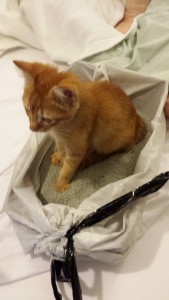 Kitty spent most of the afternoon snoozing in his crate. He and my parents dogs even mostly got along, though the dogs are understandably a bit standoffish because all previous kitty experiences they’ve had has been of the clawy hissy variety. Toward the end of the day, though, he crawled on and took his new litter box for a test drive. He took to it like a charm, though there was a bit of time when he just sat on the pile of litter like Bill the Cat. Then he hopped out and had a snooze leaned up against the leg of his new owner, my step-mother, Myra. He even has the beginnings of a similarly long tail to Lucien’s.
Kitty spent most of the afternoon snoozing in his crate. He and my parents dogs even mostly got along, though the dogs are understandably a bit standoffish because all previous kitty experiences they’ve had has been of the clawy hissy variety. Toward the end of the day, though, he crawled on and took his new litter box for a test drive. He took to it like a charm, though there was a bit of time when he just sat on the pile of litter like Bill the Cat. Then he hopped out and had a snooze leaned up against the leg of his new owner, my step-mother, Myra. He even has the beginnings of a similarly long tail to Lucien’s.
Dad consorted with his computer to come up with a proper name for the kitty. Of the five frontrunners, the name that seemed to best fit, was Abin. (Pronounced Abe-in, as in Abe Lincoln, not Abin as in Abin Sur, nerds!) As soon as he told me, I agreed it was a winner. Better still than my plan on naming the kitty after the dorm I’d found it at.
On the following day, I had to leave to return to West Virginia. I went and said goodbye to Abin and scratched him behind the ears as he likes. The parents thanked me for introducing them to their new kitty. Meanwhile, I thanked them for giving “my kitty” a proper home.
I think I will forever think of Abin as “my kitty” since I suspect he bonded with me first, and me with him. You don’t put as much work into capturing something as I did and not have feelings for it. However, I also think it was the better move to leave him with the parents. He will be of more valuable use there. It’s been a while since the parents have had the pitter patter of kitty feet.



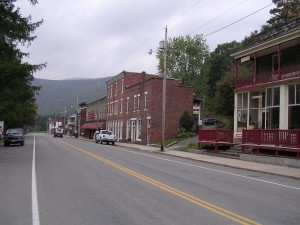
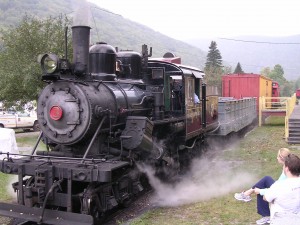
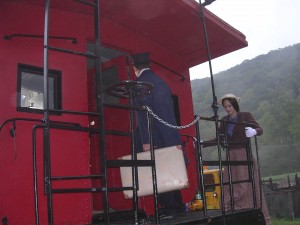

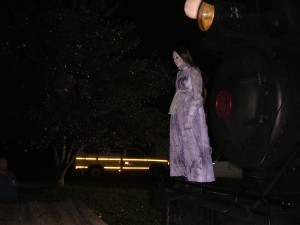
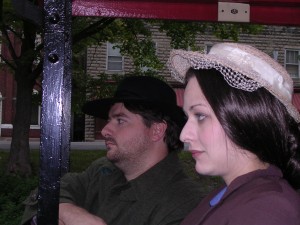
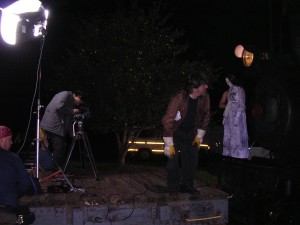
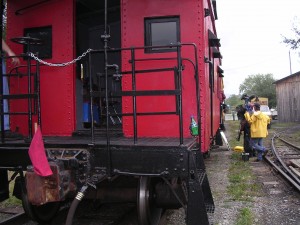
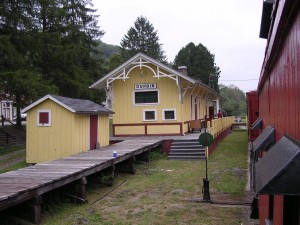
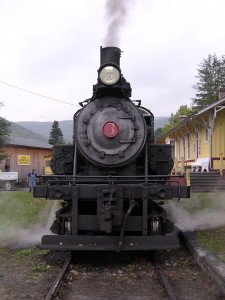 about the case of the ghost and propose a few theories about it. She, unaware of who was playing the conductor, supposed that he may have been the guy to kill the girl who became the ghost and not the guy Devin was playing at all. The funny thing is, the producers took footage from the scene where I was leading Jessica to her seat in the train and were able to zoom in and freeze on a micro expression on my face that looked a little bit sinister in order to have visual record to help shore up Susan’s theory. I never made the expression intentionally, but for a second my face registered something dark all the same.
about the case of the ghost and propose a few theories about it. She, unaware of who was playing the conductor, supposed that he may have been the guy to kill the girl who became the ghost and not the guy Devin was playing at all. The funny thing is, the producers took footage from the scene where I was leading Jessica to her seat in the train and were able to zoom in and freeze on a micro expression on my face that looked a little bit sinister in order to have visual record to help shore up Susan’s theory. I never made the expression intentionally, but for a second my face registered something dark all the same.

























 trap. I braced, waiting for the metallic clank, but heard nothing. I didn’t dare risk peeking over the lip of the concrete seat, though, for fear of scaring it away from the trap, assuming it was already there. Then I again spotted the kitty moving in the brush. I called to it, telling it how sweet it was, how I just wanted to help it, and how it would have a safe new home if only it would come out and let me catch it. I guess I was far enough away from the bench that I was not seen as a danger, for the kitty hopped back up on the curved bench and mewed.
trap. I braced, waiting for the metallic clank, but heard nothing. I didn’t dare risk peeking over the lip of the concrete seat, though, for fear of scaring it away from the trap, assuming it was already there. Then I again spotted the kitty moving in the brush. I called to it, telling it how sweet it was, how I just wanted to help it, and how it would have a safe new home if only it would come out and let me catch it. I guess I was far enough away from the bench that I was not seen as a danger, for the kitty hopped back up on the curved bench and mewed.

 from what every TV preacher (as well as a number of preachers in churches I attended) said, the End was just around the next curve in the road and we were barreling toward it in a custom van with flames painted on the sides. It was a foregone conclusion. Why else would The Omen have made so much money in theaters? The math I didn’t do then, and which not enough people do even today, is that the end of the world has ALWAYS been just around the next curve, and people have been making that claim for thousands of years. This was first pointed out to me by my grandmother, who had heard tent revival preachers say “The End is Nigh” when she was a little girl, World War I was in full swing, and things looked very much like it was lining up that way. However, with folks like Hal Lindsey walking the earth, publishing titles such as The 1980s Countdown to Armageddon, things seemed a bit grim to me during the actual 1980s. There was also the matter of some kid at school who had said he’d been told that Nostradamus had predicted that the world would end sometime between 1990 and 1996. Somehow that prediction-via-game-of-telephone seemed more real to me than a thousand books saying otherwise and I took it as gospel that Nostradamus (a man that kid at school also said had never ever been wrong on a single prediction and had not only predicted his own death but when, decades later, church officials had to exhume his body and move it somewhere else, they found a plaque on Nostradamus’s dead-assed chest with that day’s date inscribed on it, in a kind of EFF you from beyond the grave) would not be proven wrong.
from what every TV preacher (as well as a number of preachers in churches I attended) said, the End was just around the next curve in the road and we were barreling toward it in a custom van with flames painted on the sides. It was a foregone conclusion. Why else would The Omen have made so much money in theaters? The math I didn’t do then, and which not enough people do even today, is that the end of the world has ALWAYS been just around the next curve, and people have been making that claim for thousands of years. This was first pointed out to me by my grandmother, who had heard tent revival preachers say “The End is Nigh” when she was a little girl, World War I was in full swing, and things looked very much like it was lining up that way. However, with folks like Hal Lindsey walking the earth, publishing titles such as The 1980s Countdown to Armageddon, things seemed a bit grim to me during the actual 1980s. There was also the matter of some kid at school who had said he’d been told that Nostradamus had predicted that the world would end sometime between 1990 and 1996. Somehow that prediction-via-game-of-telephone seemed more real to me than a thousand books saying otherwise and I took it as gospel that Nostradamus (a man that kid at school also said had never ever been wrong on a single prediction and had not only predicted his own death but when, decades later, church officials had to exhume his body and move it somewhere else, they found a plaque on Nostradamus’s dead-assed chest with that day’s date inscribed on it, in a kind of EFF you from beyond the grave) would not be proven wrong.